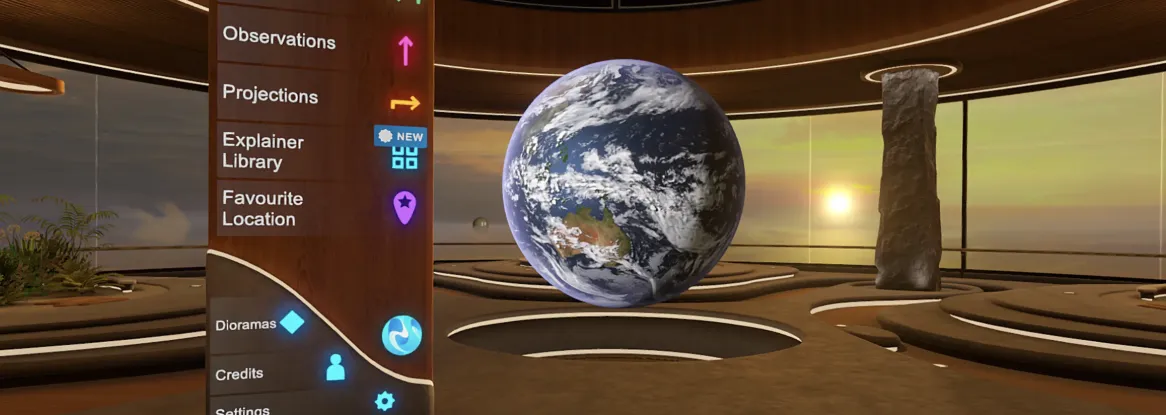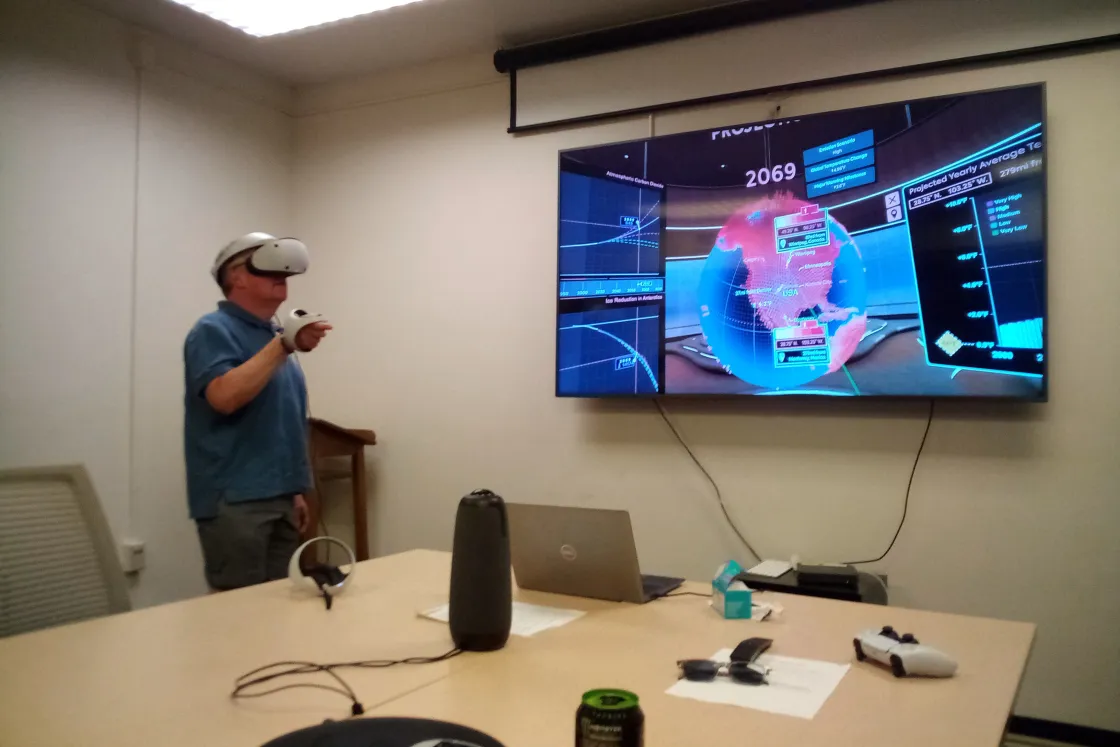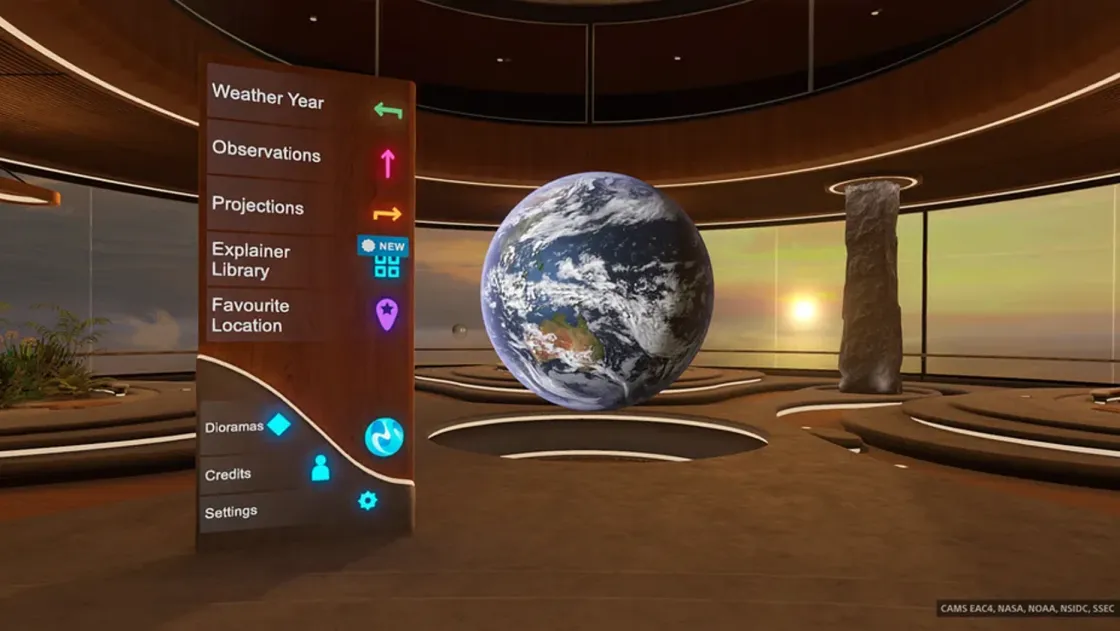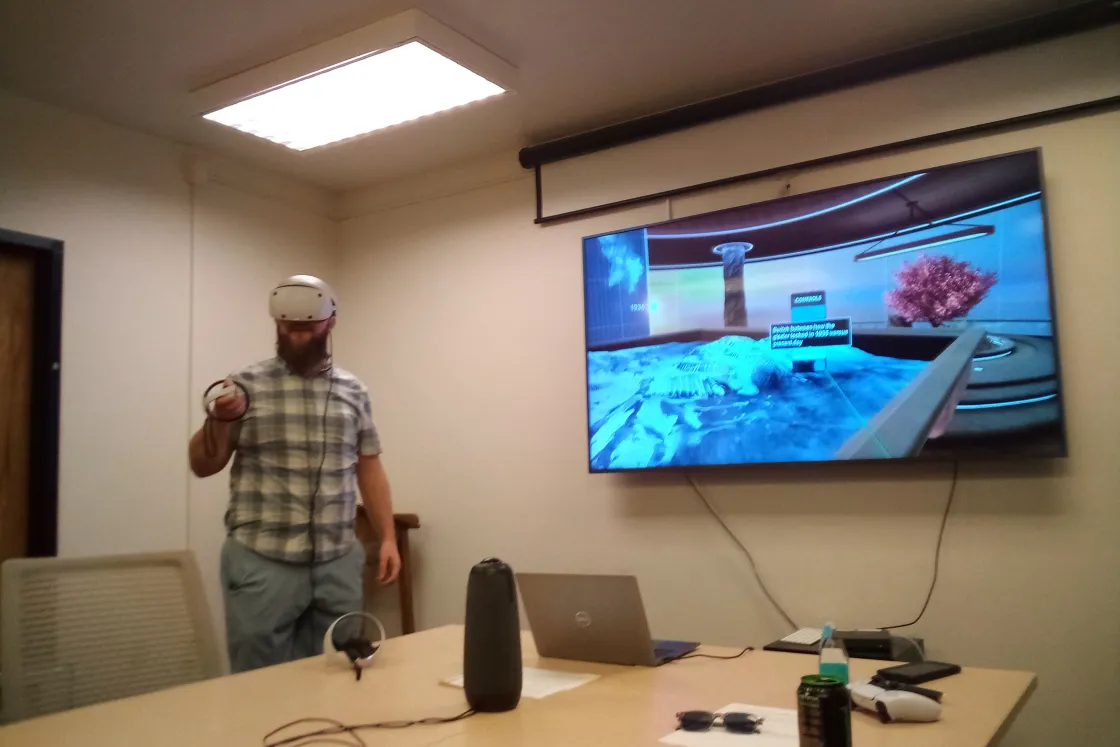By Seamus McAfee
For scientists at the National Snow and Ice Data Center (NSIDC), Arctic exploration is nothing new. They have spent careers aboard icebreakers, trekking across frozen landscapes, and poring over decades of satellite records. But on this July afternoon in Boulder, their expedition into the Arctic began not with insulated boots and snow goggles, but with a game controller and virtual reality (VR) headset.
Walt Meier, a senior research scientist at NSIDC, was among them. Slipping on the VR headset, he navigated a birds-eye-view of the icy archipelago of Svalbard, watching as glaciers disappeared in a sweeping time-lapse, decades of ice loss compressed into seconds. The immersive view offered a striking new perspective on changes he has studied for years. Then, with a shift in focus, Meier zoomed out to examine the planet’s future. Inside the Projections mode, charts of projected yearly average temperatures under different emissions scenarios towered before him, red spikes of warming seeming to surge straight toward his vantage point, as if to make it all the more personal.
Walt passed the controller and VR headset to NSIDC data support specialist Mikala Beig, who ventured further into the app’s immersive world navigating animated, interactive charts that traced a century of global temperature change. For her, the session was equal parts scientific exploration and learning to find her footing in the uncharted terrain of VR, but with the intuitive controls, she soon was navigating the app smoothly.
The occasion was a hands-on demonstration of Climate Station, a new application developed by Sony Interactive Entertainment in partnership with the United Nations’ Playing for the Planet Alliance. For Climate Station’s developers, this is not just another game, it’s a portal into the living history of our planet and the future we still have time to shape. Designed for PlayStation 5 (PS5) and enhanced for PlayStation Virtual Reality 2 (PS VR2), Climate Station puts users in the middle of Earth’s most critical story: our own.
The launch trailer for Climate Station offers a first look at how the app lets users explore melting glaciers, global temperature changes, and climate futures in an immersive, interactive experience. Credit: Sony Interactive Entertainment
The app draws on decades of satellite observations and climate modeling from NASA, the National Oceanic and Atmospheric Administration (NOAA), Berkeley Earth, and the Intergovernmental Panel on Climate Change. In fact, NSIDC staff weren’t just test driving the app—they had contributed to the very data it draws from, including the Sea Ice Index. Over 90 minutes of narrated content, voiced by climate advocate Laura Tobin, takes users through rising seas, shifting temperatures, and stark climate futures, all built from real—world data.
“It’s interactive and immersive,” Meier said. “It has lots of different things in it, like a virtual museum. It reminds me of NASA’s Earth Information Center in D.C., but you don’t have to travel there to see it.”
Climate Station is organized into three primary modes:
- Weather Year—a time-lapse of planetary change, showing storms, ice retreat, heat waves, and environmental events over 12 months.
- Observations—where the planet is now, using historical temperature data, sea ice trends, and interactive charts.
- Projections—possible futures based on varying emissions scenarios.
The app’s centerpiece, at least for this demo, was the three-dimensional diorama of Svalbard—an Arctic island chain that has seen rapid ice loss in recent decades. Using historical imagery, Climate Station renders the glaciers in exquisite detail and pulls the terrain through time, allowing viewers to watch the ice retreat from peaks and fjords.
Beyond Svalbard and the other dioramas—including a coral reef and a hurricane’s aftermath—the app immerses users in animated graphs, charts, and comparisons of global climate variables over the past year. These sequences give context to the raw numbers, turning abstract trends into something you can actually see and feel. And as a refreshing change from clicking through a flat-screen monitor, users can manipulate the visuals with hand motions, feeling a bit like a futuristic Minority Report officer in control of the data.
“The visuals are really nice—especially the 3D topography of the mountains and glaciers,” Beig said. “ I think the visual impact of the examples—like glacier retreat or coral bleaching—has the potential to make a big impression on people who would not normally have access to these types of data.”
For members of the NSIDC team who have navigated both the real Arctic and decades of climate data sets, the virtual journey offered an unexpected resonance. “Being able to see the glacier changes happen so quickly—even if you know the science—is powerful,” Meier said. “It’s a reminder that sometimes, showing is more effective than telling.”
Climate Station is now available as a free download for PS5 and PS VR2 on the PlayStation Store.



